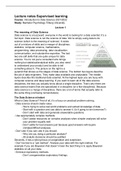Class notes
Lecture notes Introduction to Data Science Supervised learning (lecture 1-5) (UvT)
- Course
- Institution
Study: Bachelor Psychology Tilburg University Major/minor: Psychological Methods and Data Science/Applied Advanced Research Methods Course: Introduction to Data Science 2020/2021 (jaar 3) Professor: Kyle Lang Based on: Lectures and slides This course is divided in two parts: 1. Supervised l...
[Show more]



